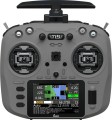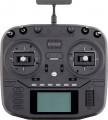Suitable for
—
For copters (FPV drones). Controllers for controlling unmanned aerial vehicles - quadcopters, multicopters and FPV drones (with first-person view). The entire functionality of the drone rests on the shoulders of the remote control: moving in the air, maneuvering, transmitting a video signal from the camera, etc. Quadcopter controllers typically have knobs, levers, or buttons that allow the pilot to control the drone's movement. In addition, the remote control can be equipped with various switches and controls for other functions (activating the camera, turning on the autopilot, and much more).
—
For helicopters. Control equipment for RC helicopters. When choosing such a controller, preference should be given to multi-channel remote controls (see “Number of channels”) - this is important for flexible control of all movements of the helicopter in the air (acceleration, climb, flight direction, rolls, auxiliary functions for switching various model options) .
—
For airplanes. Control controllers for aircraft models - airplanes, biplanes, flying wings. Such remote controls are assigned the functions of adjusting flight altitude, aircraft speed, changing flight direction using ailerons, flaps, etc. In advanced aircraft models, the controller can be used to control engine starting, landing gear extension and other advanced functions.
—
For gliders. Controllers for controlling the flight functions of gliders - aircraft models with a large wingspan (it can be more than 2 times the length of the fuselage). Radio-controlled gliders are equipped with engines, but due to the characteristics of the wing, constant operation of the engine is not required for stable flight - it is supposed to be started and “switched off” from the remote control, as well as to control other aspects of the flight.
-
For cars. Devices and devices used to control the movement of model cars, buggies, truggies, crawlers and other RC vehicles. The remote control for such self-propelled vehicles usually contains handles, levers or joysticks that control various aspects of the model's movement. The functionality of car controllers often includes control of speed, direction, braking and other additional functions (for example, turning on headlights or sound effects in some models).
—
For special equipment. Remote controls for large and “heavy” special equipment using radio control. This category includes buses, trucks, tractors, excavators, cranes and other models. The specificity of such controllers is often tied to expanded functionality, because in addition to banal movements, it is important to take into account the special capabilities of special equipment - control of the operation of lifting mechanisms, buckets, bodies for transporting goods, etc.
—
For boats. Controllers for radio-controlled water transport - boats, yachts, submarines, catamarans, jet skis. Remote controls for such models allow you to control the movement of the boat and additional functions such as turning on/off the camera, lighting or sound effects.
Display
The presence of a
display controller in the design and the type of installed matrix.
The screen in remote controls for RC models can play different roles. Thus, it is possible to display a picture from the camera in real time on a color display, and service parameters are often superimposed on top of it (for example, flight altitude, speed, remaining battery charge level, all sorts of service notifications, etc.). Monochrome screens are usually assigned other tasks - first of all, they are responsible for tracking telemetry (for more details, see the corresponding paragraph).
It is customary to equip advanced controllers for RC models with a display. Simple remote controls are often presented
without a display. And according to the types of matrices, there are the following screen options in controllers:
-
OLED. In the context of control controllers, OLED screens usually mean the simplest solutions with a black backing and white symbols for displaying settings and/or various service information. Such displays are based on organic light-emitting diodes, and their key advantage is the ability to easily read the displayed information in poor ambient lighting.
-
LCD. As a rule, these are the simplest monochrome screens - either segmented to display a limited set of characters, or based on a single-color
...LCD matrix, suitable for text and basic graphic information. LCD screens provide additional convenience: they can display various important data, for example, the flight altitude of a conventional quadcopter, the speed of movement of the RC machine, the signal level, the remaining battery charge, notifications of problems, etc.
- TFT. A TFT display means a screen consisting not of segments, but of full pixels and suitable for displaying various types of data: graphic symbols, images, and even streaming video from an installed camera. TFT screens provide the most extensive visualization of settings; they are used in controllers for controlling drones and other RC models in FPV (First Person View) mode.Screen size
Display diagonal size in inches. The larger the display, the more accurate and easier to read the information displayed on it, the better the video stream can be seen on the screen in real time. On the other hand, a display that is too large entails an increase in the size and cost of the controller. In remote controls with the ability to display only service parameters, the screen size is usually from 1 to 3 inches, in copies with full color matrices and support for broadcasting a video stream - about 5 - 7 inches diagonally.
Screen resolution
Display size in dots (pixels) horizontally and vertically. The higher the resolution of the screen, the more detailed the image can be displayed on it and the smaller objects will be clearly visible. It makes sense to pay attention to this parameter in controllers that are used to control the RC model with a first-person view in real time. The display resolution of such copies can correspond to the
Full HD format (1920x1080 pixels) or even exceed it (for example,
Quad HD - 2560x1440 pixels).
Range
The operating range of the transmitter in the control panel, in other words, is the maximum distance that the RC model can move away from the transmitter without losing control. The greater this distance, the more convenient it is to operate the car, but at the same time, powerful “long-range” transmitters have corresponding dimensions, weight and cost. In practice, the range may be less than stated - for example, due to the presence of obstacles in the signal path or due to weak batteries. Therefore, it is best to choose according to this parameter with some reserve.
External transmitter support
The option to connect an
external transmitter to the controller via micro or nano connectors allows for expanded functionality in managing RC models by supporting various communication protocols (see the relevant paragraph). For example, the default remote control operates on the TBS Crossfire protocol, while using an external transmitter allows for operation on the ELRS protocol.
Controls
The total number of controls in the remote control directly depends on the design, manufacturer, model and, most importantly, the purpose of the controller. This paragraph specifies all switches, buttons, sticks, sliders, scroll wheels and other elements used to control the RC model.
Touchscreen
The presence of
a touch display in the controller design.
Touch screens have a number of advantages over conventional ones. This display provides clearer and more convenient control than using buttons, analog levers or a traditional non-touch screen. Secondly, touchscreen displays are often quite large in size and can display not only banal symbols, but also full-color images. On the other hand, such equipment is not cheap, and the real need for it rarely arises - mainly for controlling the flights of advanced copters.
Vibration
One of the options for implementing feedback.
Vibration is the controller’s reaction to certain events occurring with the RC model. For example, it may indicate that the permissible speed or altitude limit has been exceeded, signal a strong headwind or low batteries, etc. The remote control vibrates to inform the operator about important events that should not be overlooked.

